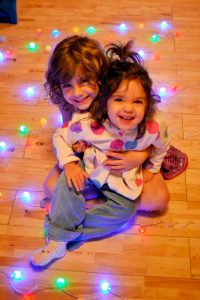Mixed aged group
 Our Little Explorers come to a small group of 9 children of different ages and stages of development in a learning environment, which prepares them for real life situation. A Multi-aged classroom is a more natural learning situation, for example, older children naturally helping younger ones.
Our Little Explorers come to a small group of 9 children of different ages and stages of development in a learning environment, which prepares them for real life situation. A Multi-aged classroom is a more natural learning situation, for example, older children naturally helping younger ones.
Our children often develop healthier social relationships and more positive attitudes. They get on better with others both children and adults. They can progress at their own pace of learning with the opportunities to join a faster or slower group.
The children will learn social skills when working together in small groups; for example: leadership skills, organisational skills,listening, sharing,taking turns,mentoring, and negotiating skills. Also will learn to resourceful and more independent self directed learners and gain the skills and attitude of learning.
THE BENEFITS OF THE MIX
SOCIAL BENEFITS TO THE CHILDREN
Preschoolers will modify their behaviour when trying to comfort a baby versus a same-age peer. Even a three year old assigns different attributes and behaviour to the picture of a younger than an older child. By about the age of four, children themselves feel pressure to match their age-mates in many behaviours and abilities. Needless to say, this pressure gives rise to strong competitive behaviours and early forms of one-upmanship!
Many parents mistakenly believe that mixing the ages only benefits the youngest children. However, the benefits go both ways. For example, in mixed-age groups older children more often exhibit leadership than the very same children show when they are among their same-age peers. Indeed, many older children who are not confident leaders in their own age group seem to feel less threatened when attempting to be leaders in mixed-age groups. They also engage in more help-giving, explaining, teaching, and sharing behaviours, and show greater sensitivity to the complexities of group processes in the mix. These are useful life skills to develop.
INTELLECTUAL BENEFITS OF AGE MIXING
Research on the development of communicative competence – a major aspect of development during the preschool years – shows that even three and four year old modify their statements depending on the ages of the persons they are addressing. For example, they modify the length and complexity, voice and tone of their verbal expression to create a favourable communication environment depending on the age of the recipient. This means that both the older and younger ones in a mixed-age group have ample opportunity to sharpen their communicative skills by taking note of the characteristics of others around them, and by «reading» their feelings and wishes.
As soon as the age range of a group is increased, the number of teachers and helpers also increases. Naturally occurring opportunities for older children to explain things to younger ones, to write things down for them, to read to them, and for them all serve to strengthen their own skilfulness. Having to teach or explain something to others makes us think carefully about our understanding of the problem – life skill of great value. Furthermore, when the older children help younger ones in this way, their sense of self-esteem and feelings of competence are strengthened by the clear firsthand evidence that they are being useful in a very real way.
